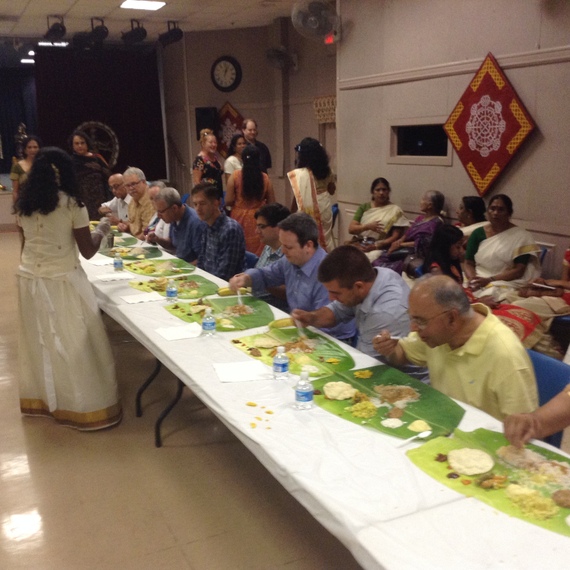As teachers prepare to return to school, they are usually inundated with professional development trainings.
Last week, many school districts around the country held their back-to-school professional development days, and the Hindu American Foundation (HAF) was busy in several states with its acclaimed Hinduism 101 training. However, for a lot of teachers, one 50-minute session is far from sufficient to be able to fully grasp -- and subsequently integrate -- new ideas and approaches when teaching about diverse cultures and faiths such as Hinduism.
That's why the first ever Teach India! East Coast workshop, organized by California State University-Long Beach, HAF, and the Sri Siva Vishnu Temple, is such an important step in allowing teachers to triangulate their teaching approaches with historical thinking and accurate content. The Teach India! workshop has run in California for the past few years, but this was the first time on the East Coast and the first partnership featuring a Hindu non-profit, major university, and Hindu temple. The workshop ran from August 20-22, and was led by CSU-Long Beach faculty members - and renowned history educators -- Tim Keirn and Dave Neumann, as well as me.
The workshop focused on applying historical thinking to teaching approaches. Sessions included HAF's Hinduism 101 program, discussions on how to read and interpret primary source documents such as the Upanishads, and lectures on Indian history from the Harappan era to modern times. Though the workshop featured lessons on how to better understand Hinduism and Hindu texts, Keirn and Neumann also highlighted India's rich cultural and religious history, including the development of Buddhism, Jainism, Sikhism and the interactions between Dharmic traditions and Abrahamic ones such as Christianity, Judaism, and Islam.
In short, the three-day workshop proved to be one of the best examples of educational praxis -- a combination of content, historical thinking and critical inquiry, and cultural immersion. Teachers who participated said their perspectives had been transformed by the professional development training and cultural immersion.
"The facilitators had a complementary understanding of India, Hinduism, historical thinking, and pedagogy which made them incredibly well-prepared to answer all our questions, often through multiple lenses," said one teacher. "The tour of the SSV Temple helped coalesce a more practical understanding of Hinduism within a larger historical context."
While content to improve pedagogy was the ultimate goal of the workshop, the cultural immersion element -- which most teachers aren't exposed to -- was vital in re-shaping the participants' perspectives. Throughout the workshop, SSVT staff and volunteers provided food and a comprehensive tour of the temple. The teachers also took part in the temple's celebration of Onam, a Hindu festival originating from the Indian state of Kerala.
"The setting, environment, and hospitality we received at SSVT made the difference," said one participant. "This is what made the experience unique from all the other workshops I have done. I will be able to tell all my students about what I experienced before I teach Hinduism. It was an experience I will never forget."
Neumann noted that the temple setting allowed for an interactivity that couldn't take place in a classroom. "Having teachers meet at the temple was a deeply enriching experience for teachers," he said.
The SSVT, which was built in Lanham, Md., in the 1980s, has served as a bedrock for multiple generations of the Hindu American community throughout the Mid-Atlantic and beyond. My family used to trek down from the Philadelphia area 30 years ago when the temple was just a small house next to an empty plot of land. Temple volunteers rarely get the sort of credit they deserve for making it such a welcoming place for visitors, yet putting together a workshop of this magnitude simply couldn't have been done without them. Moreover, SSVT has committed to making this workshop in partnership with HAF a part of their long-term investment in helping to transform the educational narratives about Hinduism and Indian spiritual traditions. This commitment is a valuable bridge between communities that have long felt marginalized and misrepresented in education content and those tasked with teaching their children.
The success of Teach India! and its growth in future years could serve as a valuable enrichment for educators looking for more than just 50-minute professional development trainings. It could, in the words of Keirn, ensure that educators view Hinduism and the expanse of Indian spirituality and culture as "living traditions" rather than abstract concepts from the pages of outdated textbooks and curriculum guidelines.

